Statue of the Tiber river with Romulus and Remus
| Statue of the Tiber river with Romulus and Remus | |
|---|---|
.jpg) Overview | |
| Location | Campus Martius |
| Built in | 1st or 2nd century CE |
| Type of structure | Statue |
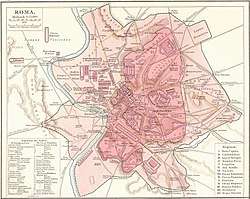 Statue of Tiber | |
The Statue of the Tiber river with Romulus and Remus is a large statue of the ancient Rome exhibited at the Louvre museum (Paris, France). It is an allegory of the Tiber River that waters the city of Rome.
Description
The Tiber is depicted as a middle-aged man, bearded, and half lying, according to the patterns of typical representation of the gods-river.
He holds the attributes signifying the benefits he lavishes to Rome:
- In his left hand, an oar evokes navigation;
- In his right hand, the cornucopia recalls the nourishing virtues of the river.
At the foot of the statue lies the she-wolf breastfeeding the twins Romulus and Remus, who had been abandoned in the Tiber river and who will be later at the origin of the mythical founding of Rome.
The base of the statue is decorated with reliefs depicting a scene of grazing, another of boatmen and other one relative to the myth of Aeneas.
Its dimensions are the following: 3.17m wide, 1.65m tall, 1.31m deep[1].
It is made from marble taken from Mount Pentelicus near Athens in Greece[1].
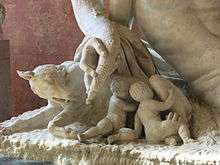 Romulus and Remus at the foot of the statue.
Romulus and Remus at the foot of the statue._reliefs_4.jpg) House of Troy defeated by the Greeks and Aeneas flying before founding Rome.
House of Troy defeated by the Greeks and Aeneas flying before founding Rome.
Location

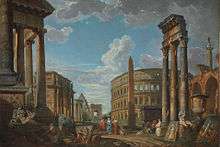
The statue was discovered in 1512 in Rome at the site of the Temple of Isis and Serapis, near the present-day basilica Santa Maria sopra Minerva[1].
The statue undoubtedly decorated a fountain placed along the path leading to the sanctuary. It mirrored a statue of the Nile (now preserved in the Vatican) where Romulus and Remus were replaced by a crowd of children representing pygmies.
History
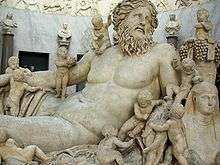
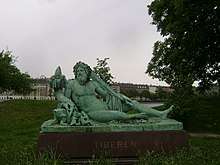
After their discovery, the two statues were preserved in the papal collections. Following the Treaty of Tolentino (1797) between the French Republic and the Papal States, the two statues were transferred to the Louvre, where their presence was attested in 1811. In 1815, after the defeat of Napoleon, the statue of the Nile was returned to the Vatican. But the statue of Tiber was offered by the pope Pius VII to the French king Louis XVIII and remained in the Louvre.
The image of the statue of the Tiber was widely circulated and was the subject of numerous marble or bronze replicas.
Dating
The dating of the sculpture is uncertain. It was probably installed after the fire of the Temple of Isis in 80 CE. But it could be from the later Hadrian period (117-138 CE).
Notes & References
- 1 2 3 http://www.louvre.fr/en/oeuvre-notices/tiber Notices (in english) about the statue on the site Louvre.fr
Bibliography
J. Le Gall, « Les Bas-reliefs de la statue du Tibre », in Revue archéologique, 1944.
Related articles
External links
| Wikimedia Commons has media related to Tiber river with Romulus and Remus (Louvre Ma593). |